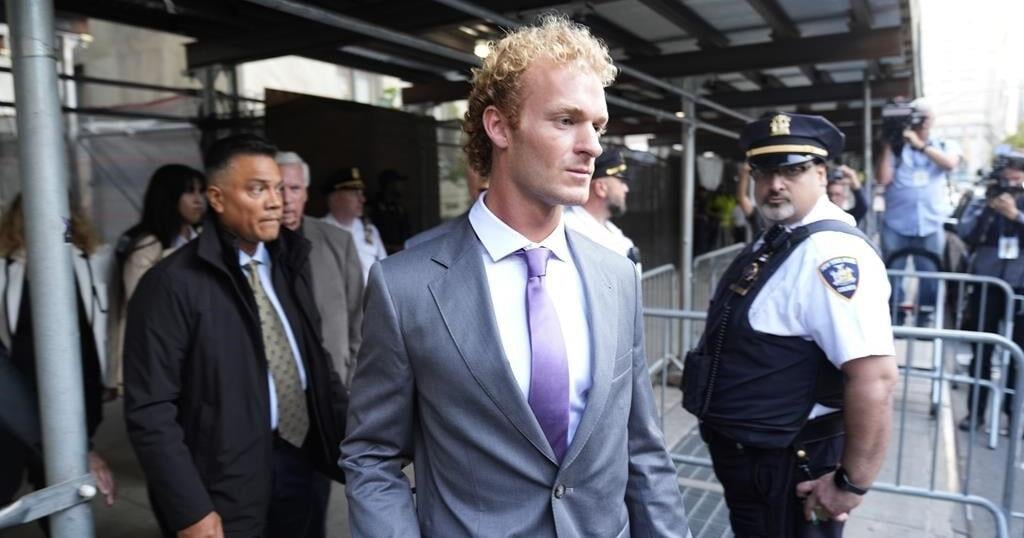NEW YORK (AP) — To some New Yorkers, he’s the white vigilante who choked an innocent Black man to death on the subway. To others, he’s the U.S. Marine Corps veteran whose attempt to subdue a mentally ill man ended in tragedy.
A Manhattan jury will soon have its say on Daniel Penny, who is charged with manslaughter for placing Jordan Neely in a fatal chokehold on May 1, 2023. Jury selection in Penny’s trial begins Monday.
The court proceedings, which are expected to last six weeks, will shed light on a killing that was a flashpoint in the nation’s debate over racial injustice and crime.
Neely’s death also divided a city grappling with what to do about people experiencing mental health crises in a transit system where some subway straphangers still don’t feel safe, despite a drop in violent crime rates.
“There is simply no reason for Jordan Neeley to be dead today,” David Giffen, executive director of the Coalition for the Homeless, told The Associated Press on Wednesday. “So many systems failed Jordan and contributed to his death.”
Penny, 25, has been free on a $100,000 bond. He faces up to 15 years in prison if convicted of second-degree manslaughter and up to four years if convicted of criminally negligent homicide.
Witnesses said Neely — a 30-year-old former Michael Jackson street impersonator struggling with drug addiction, mental illness and homelessness — had been shouting, throwing things and acting erratically on a subway train in Manhattan when Penny approached him.
With the help of two other passengers, Penny pinned Neely to the ground and placed him in a chokehold for more than three minutes until Neely’s body went limp and he lost consciousness. The medical examiner’s office ruled the death a homicide caused by compression of the neck.
The encounter sparked nearly two weeks of protests before Manhattan District Attorney Alvin Bragg’s office brought an indictment.
Meanwhile, millions of dollars in donations poured in from across the country to help Penny cover his legal costs, including from prominent conservative personalities and Republican candidates for president.
Penny’s lawyers have argued that the Long Island native didn’t intend to kill Neely, just to hold him down long enough for police to arrive, as he was concerned for the safety of others.
“If Danny is convicted, his conviction will have a chilling effect on every New Yorker’s right and duty to stand up for each other,” Penny’s lawyer Steven Raiser said Wednesday. “Our sincerest hope is that New Yorkers selected for this jury will stand up for Danny just like Danny stood up for them back on that train over a year ago today.”
Penny, who served four years in the Marines before being discharged in 2021, claimed that Neely shouted “I’m gonna’ kill you” and that he was “ready to die” or go to jail for life.
But Neely’s family and supporters have said he was simply crying out for help. They said his mental health deteriorated after his mother’s body was found stuffed in a suitcase in the Bronx and he testified at her boyfriend’s murder trial.
Some witnesses, including a freelance journalist who captured video of some of the altercation, also said Neely had been acting aggressively and frightening people but hadn’t attacked anyone before Penny pulled him to the floor.
Neely’s surviving family members say they’ve been anticipating this moment and intend to attend the trial.
“I just want to look into his face and wonder why he would do something like that,” said Mildred Mahazu, Neely’s 85-year-old aunt and primary caretaker after his mother died. “Jordan was somebody’s child. He was loved by his family.”
Neely’s uncle, Christopher Neely, agreed.
“Justice for Jordan is all we think about,” the 45-year-old Manhattan resident said. “We can’t let Jordan’s name be added to the list of Black people killed by a racist white person with no justice.”
Prosecutors argued in court filings that Penny’s actions were unwarranted, reckless and negligent, even if he didn’t have the intention to kill.
They’ve focused on recorded statements Penny made to police in which he describes Neely as a “crackhead,” touts his armed forces experience and demonstrates to officers the submission technique he used.
“I just put him out. I just put him in a chokehold,” Penny said, according to a transcript of the recordings included in court filings. “He was threatening everybody.”
“I’m not trying to kill the guy,” Penny said at another point to police. “I’m just trying to deescalate the situation.”
Bragg’s office declined to comment beyond what its said in court filings. Prosecutors, in pretrial hearings, sought to exclude evidence about Neely’s medical and psychological history, including his record of substance abuse. The judge hadn’t released his ruling on that request as of Friday.
Raiser said Penny’s defense will offer up other potential causes for Neely’s death, including high levels of the synthetic cannabinoid known as K2 that were identified in toxicology reports.
They’ll also argue that video shared widely on social media proves Penny was not applying pressure consistently enough to render Neely unconscious, much less kill him, he said.
“If he was applying that kind of pressure, Mr. Neely would have been rendered unconscious long before the video, circulating online, ever started,” Raiser said.
In January, Penny’s lawyers lost their bid to have the case dismissed outright. Then earlier this month, Judge Maxwell Wiley rejected their request to prevent jurors from hearing Penny’s statements to police, as well as body camera footage from officers who initially responded.
Penny’s attorneys argued that police should have read Penny his Miranda rights sooner and that his questioning at the police station amounted to an illegal arrest.
But Wiley, in a written ruling, determined that Penny’s statements were admissible. The judge said Penny had waived his rights against self-incrimination in the interrogation room and willingly spoke to officers without a lawyer present.
As for Christopher Neely, he hopes what’s not lost in the trial is the memory of his late nephew.
“I want people to remember his strengths and his conquests to greatness and his conquering of fears,” he wrote. “I want people to remember that mental health is a serious issue and that it needs tenderness, not spontaneous rage. Most importantly, I want people to know that Jordan Neely was supremely loved and still is.”
___
Follow Philip Marcelo at twitter.com/philmarcelo.

























